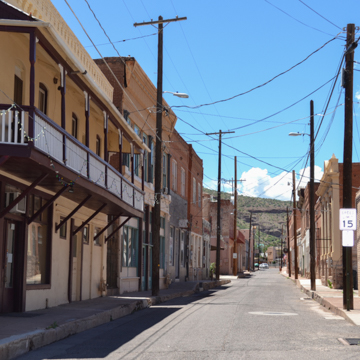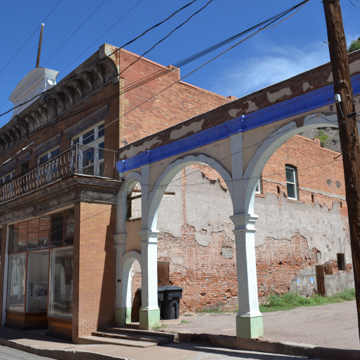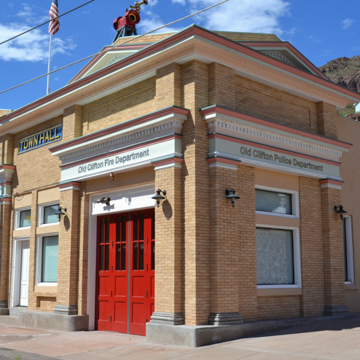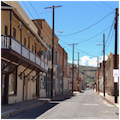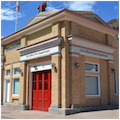Shortly after the creation of Arizona Territory in 1863, gold and silver prospectors began to visit the San Francisco River Canyon a few miles north of its confluence with the Gila River, near the New Mexico border. They included Mason Greenlee and Henry Clifton, from the newly established capital of Prescott, and Joe Yankie out of Pinos Altos, New Mexico. Another was Robert Metcalf, a Civil War veteran and former Army scout, who detected the presence of copper deposits and enlisted his brother, Jim, and nephews, Charles and Baylor Shannon, to stake claims in the area. Establishing a profitable mining operation proved difficult because of the remote location, the complexities of extracting the red mineral from its ore body, and ongoing conflicts with Apaches.
Recognizing the need for additional capital to continue the mining venture, the Metcalfs sought backing from businessmen Charles and Henry Lesinsky of Silver City, New Mexico. Along with their uncle Jules Freudenthal, the Lesinskys soon acquired the Metcalf claim and several others in the area. By 1873 Henry had begun mining the rich veins of relatively accessible copper ore. He established smelting operations at the confluence of Chase Creek and the San Francisco River, recruiting experienced miners and smelter workers from the northern Mexican states of Sonora and Chihuahua. He also built the camp’s first permanent commercial structure. Lesinsky’s activities marked the beginning of Arizona’s first sustained copper mining venture. By 1880, the Church brothers had also established their Detroit Copper Company nearby in what would become the town of Morenci.
Not until the arrival of the railroad in the early 1880s, combined with the subjugation of the native population, did mining operations in the area first become lucrative to outside interests. By now exhausted from their efforts to establish and work their operations, the Lesinsky brothers sold their holdings to Kansas City entrepreneur Frank Underwood in September 1882. Six months later Underwood sold them to a group of Scottish investors, who organized as the Arizona Copper Company (ACC). The subsequent infusion of capital and introduction of more sophisticated extraction techniques made mining on a larger scale possible. The ACC sent administrators and engineers to oversee and cultivate their investment, chief among them James Colquhoun, whose innovations allowed lower-grade ore to be mined and processed profitably. While never owning the town outright, as Phelps Dodge eventually did in nearby Morenci, the ACC became the dominant economic and civic force in the community. It had competition in this regard from the Shannon Copper Company.
The first permanent residences, mostly traditional adobe buildings, had sprung up near the ACC smelter in the middle of the settlement. The earliest commercial district arose along Conglomerate Avenue (later Park Avenue) on Clifton’s east side, across the river and opposite the ACC reduction works at the confluence of Chase Creek. This is where Henry Lesinsky had built his original store, which was later joined by several other commercial buildings and private houses climbing up the mountainside behind.
A relatively flat area to the north of the smelter, between the omnipresent cliffs and the river, became the community’s first distinct neighborhood and was home to many ACC employees. It was here and along the east side that imported building materials and architectural styles first became evident.
In 1901, Henry Hill laid out his addition to the south, providing ample space for the construction of houses, schools, and commercial buildings for the expanding community, many in Victorian/Edwardian, Classical, and Arts and Crafts styles. Here, too, the county courthouse was erected on property Hill donated after Greenlee was carved out of Graham County in 1911, just prior to statehood. Hill’s addition, which became known as South Clifton relative to the original town center, soon became the community’s fashionable residential district.
By 1909, the Chase Creek district, along Copper Avenue (Chase Creek Street) west of the smelter area and parallel to the creek itself, had become Clifton’s primary commercial center. The ouster of several brothels and saloons from the social climbing east side fueled the district’s respectable development. Prior to this, Clifton, the Chase Creek District in particular, was as rough and rowdy as any mining town in the Southwest, complete with brawls, shoot-outs, labor disputes, and itinerant desperados. An April 1913 fire destroyed most of the makeshift wood frame buildings in the district and, combined with a robust economy buoyed by high copper prices, a building boom ensued. Many of those commercial brick buildings remain today, their cheek-by-jowl storefronts forming the most intact stretch of late territorial and early statehood–era architecture in Arizona.
Clifton’s citizenry meanwhile, continued to grow more diverse as Spanish, Italian, Chinese, and Scottish immigrants arrived to work alongside the original German-Jewish, northern Mexican, and southwestern American inhabitants, whether in the mines and smelters or servicing the needs of those who did.
Significant buildings from this era include the ACC General Offices (1906), the opulent ACC General Manager’s Residence (1913), the Arizona and New Mexico Railway Passenger Depot (1913), and the Classical Clifton Town Hall (1920) designed by local architect Duncan McNeil, a likely Scottish immigrant himself.
By the early 1900s, East Coast copper importer Phelps Dodge and Company (PD) had acquired the Detroit Copper Company, as well as nearly all other holdings not already owned by the ACC. Around this time, development of the town of Morenci began in earnest at the headframes of most of the area’s mines, seven miles distant and 1,300 feet higher in elevation from Clifton. Prolific Southwestern architect Henry Trost designed several community and company buildings there.
In 1921, during a period of low copper prices and vexed by American and British taxation, the ACC negotiated with PD for the transfer of all their holdings; when this was completed on January 1, 1922, PD was the only major copper producer in the region. Smelting operations remained in Clifton, but little significant building activity occurred in what was now the “corporate step town.” The lone exception was a 1928 bathhouse and pool in the fashionable Spanish Colonial Revival style, funded by community investors hoping to attract tourists to the mineral hot springs near the river. The ensuing depression dashed this dream, and the building later became a medical clinic and insurance offices.
Though Clifton experienced periodic floods throughout its history, the 1983 flood was especially devastating, since it occurred in the midst of a three-year labor strike by miners. Clifton never fully recovered, although a flood control project has added increased protection against future catastrophes. This federally funded project resulted in the survey and inventory of Clifton’s historic core. In 1990, the Clifton Town Site Historic District was listed in the National Register of Historic Places.
References
Ascarza, William. “Scottish engineer helped save Arizona Copper Co.” The Arizona Daily Star, July 12, 2015.
Graham, Robert (Ryden Architects), “Clifton Townsite Historic District,” Greenlee County, Arizona. National Register of Historic Places Inventory–Nomination Form, 1989. National Park Service, U.S. Department of the Interior, Washington D.C.
Kupel, Douglas E. “Taking a Bath: Civic Improvement in Clifton.” The Journal of Arizona History37 (Autumn 1996): 269-282.
Patton, James M. History of Clifton.Clifton, AZ: Greenlee County Chamber of Commerce, 1977.
Philips, David A., and Harris Sobin. Clifton’s Historic Buildings: A Flood Control-Related Cultural Resources Study of Clifton, Greenlee County, Arizona.U.S. Army Corps of Engineers, 1985.
Ryden Architects, Inc. Clifton Townsite Historic American Buildings Survey, Vols. 1-3. U.S. Army Corps of Engineers, 1995.
Spezia, Charles A. Walking Tour of Historic Chase Creek, Clifton Arizona, 1900-1929. Clifton, AZ: Self-published, 1990.
Vinson, Mark. “Vanished Clifton-Morenci: An Architect’s Perspective.” The Journal of Arizona History(Summer 1992): 183-206.
Zindel, Udo. Landscape Evolution in the Clifton-Morenci Mining District, Arizona, 1872-1986.Master’s thesis, Arizona State University, 1987.














